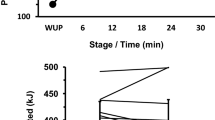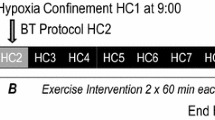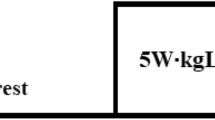Abstract
The purpose of this study was to determine the effect of low, moderate and high wet bulb globe temperatures (T wbg) on cardiovascular variables and ratings of perceived exertion (RPE) during moderately prolonged, high-intensity exercise. Six subjects [four men and two women; mean (SD) age, 22.0 (1.2) years; maximum oxygen consumption ({ie519-1}), 51.0 (8.4) ml · kg−1 · min−1] completed 30 min of exercise (80% {ie519-2}) on a cycle ergometer at low [14.7 (2.1)°C], moderate [21.0 (1.5)° C], and high [27.4 (2.3)° C]T wbg. Two additional subjects completed 20 min of exercise in the high temperature condition, but completed 30 min in the moderate and lowT wbg. Heart rate (f c), blood pressure, blood lactate (La), mean skin temperature (\(\bar T\) sk),\(\dot V\), and RPE were measured at 10, 20 and 30 min. Results showed thatf c, rate pressure product, RPE, pulmonary ventilation and ventilatory equivalent for oxygen increased (P < 0.05) across time for all conditions, while\(\bar T\) decreased across time.\(\bar T\) sk andf c were significantly greater across time in the high condition [35.9 (0.65)° C; 176 (12.6) beats · min−1] compared to the moderate [34.6 (1.5)° C; 170 (17.2) beats · min−1] and the low condition [31.7 (1.5)° C; 164 (17.1) beats-min−1]. However, there were no differences throughout exercise in RPE [high,.16.2 (2.0); moderate, 16.4 (2.2); low, 16.3 (1.9)] and\(\dot V\) across the conditions. These data suggest that RPE is closely related to metabolic intensity but is not a valid indicator of cardiovascular strain during exercise in highT wbg conditions.
Similar content being viewed by others
References
American College of Sports Medicine (AGSM) (1984) Position stand on the prevention of thermal injuries during distance running. Med Sci Sports Exerc 16: ii
American College of Sports Medicine (1991) Guidelines for exercise testing and prescription, 4th edn. Lea and Febiger
Bayles CM, Metz KF, Robertson R, Goss FL, Cosgrove J, McBurney D (1990) Perceptual regulation of prescribed exercise. J Cardiopulmonary Rehabil 10:25–31
Borg G (1970) Perceived exertion as an indicator of somatic stress. Scand J Rehabil Med 2:92–98
Brouha L, Smith PE, De Lanne R, Maxfield ME (1960) Physiological reactions of men and women during muscular activity and recovery in various environments. J Appl Physiol 16:133–140
Brouha L, Maxfield ME, Smith PE, Stopps GJ (1963) Discrepancy between heart rate and oxygen consumption during work in the warmth. J Appl Physiol 18:1095–1098
Burton AC (1948) Temperature of the skin: measurement and use as index of peripheral blood flow. In: Van Potter R (ed) Methods in medical research, vol 1. Year Book, Chicago, p 146
Chow RJ, Wilmore JH (1984) The regulation of exercise intensity by ratings of perceived exertion. J Cardiac Rehabil 4:382–387
Consolazio CF, Matoush LO, Nelson RA, Torres JB, Issaac GJ (1963) Environmental temperature and energy expenditures. J Appl Physiol 18:65–68
Dimri GP, Malhorta MS, Gupta JS, Kumar TS, Arora BS (1980) Alterations in aerobic-anaerobic proportions of metabolism during work in heat. Eur J Appl Physiol 45:43–50
Dishman RK, Patton RW, Smith I, Weinberg R, Jackson A (1987) Using perceived exertion to prescribe and monitor exercise training heart rate. Int J Sports Med 8:208–213
Ekblom B, Goldbarg AN (1971) The influence of physical training and other factors on the subjective rating of perceived exertion. Acta Physiol Scand 83:399–406
Eston RG, Davies BL, Williams JG (1987) Use of perceived effort ratings to control exercise intensity in young healthy adults. Eur J Appl Physiol 56:222–224
Glass SC, Knowlton RG, Becque MD (1992) Accuracy of RPE from graded exercise to establish exercise training intensity. Med Sci Sports Exerc 24:1303–1307
Hartzell AA, Freund BJ, Jilka SM, Joyner MJ, Anderson RL, Ewy GA, Wilmore JH (1986) The effect of beta-adrenergic blockade on ratings of perceived exertion during submaximal exercise before and following endurance training. J Cardiopulmonary Rehabil 6:444–456
Huey KA, Hagen RD, Bennett BL, Minson C, Cain D (1993) Effect of cooling vests on thermal sensation and perceived exertion during heat exposure. Med Sci Sports Exerc 25:S138
International Standards Oganization (ISO) (1982) Hot environments — estimation of heat stress on working man based on the WBGT index (wet bulb globe temperature). ISO 7243
Katch FI, Michael ED, Horvath SM (1967) Estimation of body volume by underwater weighing; description of a simple method. J Appl Physiol 23:811–813
Mihevic PM (1981) Sensory cues for perceived exertion: a review. Med Sci Sports Exerc 13:150–163
Morgan WP, Borg G (1976) Perception of effort in the prescription of physical activity. In: Craig T (ed) The humanistic and mental health aspects of sports, exercise and recreation. American Medical Association, Chicago, pp 256–259
National Institute for Occupational Safety and Health (NIOSH) (1986) Criteria for a recommended standard ... occupational exposure to hot environments. U.S. Dept. of Health and Human Services, Public Health Services, Centers for Disease Control
Nobel BJ, Metz KF, Pandolf KB, Cafarelli E (1973) Perceptual responses to exercise: a multiple regression study. Med Sci Sports 5:104–109
Pandolf K, Cafarelli E, Noble B, Metz K (1972) Perceptual responses during prolonged work. Percept Mot Skills 35:975–985
Pandolf KB, Cafarelli E, Noble BJ, Metz KF (1975) Hyperthermia: effect on exercise prescription. Arch Phys Med Rehabil 56:524–526
Pandolf KB, Sawka MN, Gonzalez RR (eds) (1988) Human performance physiology and environmental medicine at terrestrial extremes. Benchmark Press, Indianapolis, pp 112–126
Pedhazur EJ (1982) Multiple regression in behavioral research, 2nd edn Holt, Rinehart, Winston, Fort Worth, pp 315–316
Robertson RJ (1982) Central signals of perceived exertion during dynamic exercise. Med Sci Sports Exerc 14:390–396
Robertson RJ, Goss FL, Auble TE, Cassinelli DA, Spina RJ, Glickman EL, Galbreath RW, Silberman RM, Metz KF (1990) Cross-modal exercise prescription at absolute and relative oxygen uptake using perceived exertion. Med Sci Sports Exerc 22:653–659
Rowell LB (1974) Human cardiovascular adjustments to exercise and thermal stress. Physiol Rev 54:75–159
Scholander PF (1947) Analyzer for accurate estimation of respiratory gases in one-half cubic centimeter samples. J Biol Chem 167:235–250
Skinner JS, Hutsler R, Bergsteinova V, Buskirk ER (1973) Perception of effort during different types of exercise and under different environmental conditions. Med Sci Sports 5:110–115
Smutok MA, Skrinar GS, Pandolf KB (1980) Exercise regulation: subjective regulation by perceived exertion. Arch Phys Med Rehabil 61: 569–574
Wilmore JH, Vodak PA, Girandola RN, Billing JE (1980) Further simplification of a method for detmerination of residual lung volume. Med Sci Sports Exerc 12:216–218
Yaglou CP, Minard D (1957) Control of heat casualties at military training centers. AMA Arch Ind Health 16:302–305
Author information
Authors and Affiliations
Rights and permissions
About this article
Cite this article
Glass, S.C., Knowlton, R.G. & Becque, M.D. Perception of effort during high-intensity exercise at low, moderate and high wet bulb globe temperatures. Europ. J. Appl. Physiol. 68, 519–524 (1994). https://doi.org/10.1007/BF00599523
Accepted:
Issue Date:
DOI: https://doi.org/10.1007/BF00599523




